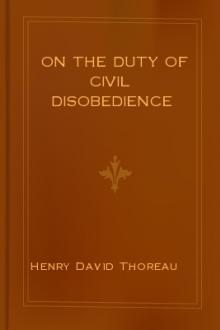Essays Henry David Thoreau (little bear else holmelund minarik .txt) 📖

- Author: Henry David Thoreau
Book online «Essays Henry David Thoreau (little bear else holmelund minarik .txt) 📖». Author Henry David Thoreau
The most interesting object in Canada to me was the River St. Lawrence, known far and wide, and for centuries, as the Great River. Cartier, its discoverer, sailed up it as far as Montreal in 1535—nearly a century before the coming of the Pilgrims; and I have seen a pretty accurate map of it so far, containing the city of “Hochelaga” and the river “Saguenay,” in Ortelius’s Theatrum Orbis Terrarum, printed at Antwerp in 1575—the first edition having appeared in 1570—in which the famous cities of “Norumbega” and “Orsinora” stand on the rough-blocked continent where New England is today, and the fabulous but unfortunate Isle of Demons, and Frislant, and others, lie off and on in the unfrequented sea, some of them prowling near what is now the course of the Cunard steamers. In this ponderous folio of the “Ptolemy of his age,” said to be the first general atlas published after the revival of the sciences in Europe, only one page of which is devoted to the topography of the Novus Orbis, the St. Lawrence is the only large river, whether drawn from fancy or from observation, on the east side of North America. It was famous in Europe before the other rivers of North America were heard of, notwithstanding that the mouth of the Mississippi is said to have been discovered first, and its stream was reached by Soto not long after; but the St. Lawrence had attracted settlers to its cold shores long before the Mississippi, or even the Hudson, was known to the world. Schoolcraft was misled by Gallatin into saying that Narvaez discovered the Mississippi. De Vega does not say so. The first explorers declared that the summer in that country was as warm as France, and they named one of the bays in the Gulf of St. Lawrence the Bay of Chaleur, or of warmth; but they said nothing about the winter being as cold as Greenland. In the manuscript account of Cartier’s second voyage, attributed by some to that navigator himself, it is called “the greatest river, without comparison, that is known to have ever been seen.” The savages told him that it was the “chemin du Canada”—the highway to Canada—“which goes so far that no man had ever been to the end that they had heard.” The Saguenay, one of its tributaries, which the panorama has made known to New England within three years, is described by Cartier, in 1535, and still more particularly by Jean Alphonse, in 1542, who adds, “I think that this river comes from the sea of Cathay, for in this place there issues a strong current, and there runs there a terrible tide.” The early explorers saw many whales and other sea-monsters far up the St. Lawrence. Champlain, in his map, represents a whale spouting in the harbor of Quebec, three hundred and sixty miles from what is called the mouth of the river; and Charlevoix takes his reader to the summit of Cape Diamond to see the “porpoises, white as snow,” sporting on the surface of the harbor of Quebec. And Boucher says in 1664, “from there (Tadoussac) to Montreal is found a great quantity of Marsouins blancs.” Several whales have been taken pretty high up the river since I was there. P. A. Gosse, in his Canadian Naturalist, p. 171 (London, 1840), speaks of “the white dolphin of the St. Lawrence (Delphinus canadensis)” as considered different from those of the sea. “The Natural History Society of Montreal offered a prize, a few years ago, for an essay on the cetacea of the St. Lawrence, which was, I believe, handed in.” In Champlain’s day it was commonly called “the Great River of Canada.” More than one nation has claimed it. In Ogilby’s America of 1670, in the map Novi Belgii, it is called “De Groote Rivier van Niew Nederlandt.” It bears different names in different parts of its course, as it flows through what were formerly the territories of different nations. From the Gulf to Lake Ontario it is called at present the St. Lawrence; from Montreal to the same place it is frequently called the Cateraqui; and higher up it is known successively





Comments (0)